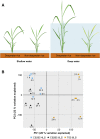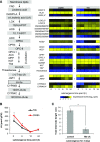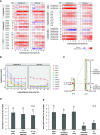Time-Course Transcriptomics Analysis Reveals Key Responses of Submerged Deepwater Rice to Flooding
- PMID: 29475897
- PMCID: PMC5884608
- DOI: 10.1104/pp.17.00858
Time-Course Transcriptomics Analysis Reveals Key Responses of Submerged Deepwater Rice to Flooding
Abstract
Water submergence is an environmental factor that limits plant growth and survival. Deepwater rice (Oryza sativa) adapts to submergence by rapidly elongating its internodes and thereby maintaining its leaves above the water surface. We performed a comparative RNA sequencing transcriptome analysis of the shoot base region, including basal nodes, internodes, and shoot apices of seedlings at two developmental stages from two varieties with contrasting deepwater growth responses. A transcriptomic comparison between deepwater rice cv C9285 and nondeepwater rice cv Taichung 65 revealed both similar and differential expression patterns between the two genotypes during submergence. The expression of genes related to gibberellin biosynthesis, trehalose biosynthesis, anaerobic fermentation, cell wall modification, and transcription factors that include ethylene-responsive factors was significantly different between the varieties. Interestingly, in both varieties, the jasmonic acid content at the shoot base decreased during submergence, while exogenous jasmonic acid inhibited submergence-induced internode elongation in cv C9285, suggesting that jasmonic acid plays a role in the submergence response of rice. Furthermore, a targeted de novo transcript assembly revealed transcripts that were specific to cv C9285, including submergence-induced biotic stress-related genes. Our multifaceted transcriptome approach using the rice shoot base region illustrates a differential response to submergence between deepwater and nondeepwater rice. Jasmonic acid metabolism appears to participate in the submergence-mediated internode elongation response of deepwater rice.
© 2018 American Society of Plant Biologists. All Rights Reserved.
Figures








Similar articles
-
Ethylene is not involved in adaptive responses to flooding in the Amazonian wild rice species Oryza grandiglumis.J Plant Physiol. 2015 Feb 1;174:49-54. doi: 10.1016/j.jplph.2014.09.012. Epub 2014 Oct 6. J Plant Physiol. 2015. PMID: 25462966
-
Ethylene-gibberellin signaling underlies adaptation of rice to periodic flooding.Science. 2018 Jul 13;361(6398):181-186. doi: 10.1126/science.aat1577. Science. 2018. PMID: 30002253
-
Comparison of the role of gibberellins and ethylene in response to submergence of two lowland rice cultivars, Senia and Bomba.J Plant Physiol. 2011 Feb 15;168(3):233-41. doi: 10.1016/j.jplph.2010.07.023. J Plant Physiol. 2011. PMID: 20889230
-
Regulation of submergence-induced enhanced shoot elongation in Oryza sativa L.Ann Bot. 2003 Jan;91 Spec No(2):263-70. doi: 10.1093/aob/mcf121. Ann Bot. 2003. PMID: 12509346 Free PMC article. Review.
-
Finding a breather for Oryza sativa: Understanding hormone signalling pathways involved in rice plants to submergence stress.Plant Cell Environ. 2022 Feb;45(2):279-295. doi: 10.1111/pce.14250. Epub 2021 Dec 31. Plant Cell Environ. 2022. PMID: 34971465 Review.
Cited by
-
Characterization of Atypical Protein Tyrosine Kinase (PTK) Genes and Their Role in Abiotic Stress Response in Rice.Plants (Basel). 2020 May 23;9(5):664. doi: 10.3390/plants9050664. Plants (Basel). 2020. PMID: 32456239 Free PMC article.
-
GhSBI1, a CUP-SHAPED COTYLEDON 2 homologue, modulates branch internode elongation in cotton.Plant Biotechnol J. 2024 Nov;22(11):3175-3193. doi: 10.1111/pbi.14439. Epub 2024 Jul 26. Plant Biotechnol J. 2024. PMID: 39058556 Free PMC article.
-
The Role of Phytohormones in Plant Response to Flooding.Int J Mol Sci. 2022 Jun 7;23(12):6383. doi: 10.3390/ijms23126383. Int J Mol Sci. 2022. PMID: 35742828 Free PMC article. Review.
-
Salt-responsive transcriptome analysis of triticale reveals candidate genes involved in the key metabolic pathway in response to salt stress.Sci Rep. 2020 Nov 26;10(1):20669. doi: 10.1038/s41598-020-77686-8. Sci Rep. 2020. PMID: 33244037 Free PMC article.
-
Depicting the molecular responses of adventitious rooting to waterlogging in melon hypocotyls by transcriptome profiling.3 Biotech. 2021 Jul;11(7):351. doi: 10.1007/s13205-021-02866-w. Epub 2021 Jun 21. 3 Biotech. 2021. PMID: 34221821 Free PMC article.
References
-
- Azuma T, Hirano T, Deki Y, Uchida N, Yasua T, Yamaguchi T (1995) Involvement of the decrease in levels of abscisic acid in the internodal elongation of submerged floating rice. J Plant Physiol 146: 323–328
-
- Bailey TL, Elkan C (1994) Fitting a mixture model by expectation maximization to discover motifs in biopolymers. Proc Int Conf Intell Syst Mol Biol 2: 28–36 - PubMed
-
- Bailey-Serres J, Voesenek LA (2008) Flooding stress: acclimations and genetic diversity. Annu Rev Plant Biol 59: 313–339 - PubMed
-
- Bailey-Serres J, Voesenek LA (2010) Life in the balance: a signaling network controlling survival of flooding. Curr Opin Plant Biol 13: 489–494 - PubMed
Publication types
MeSH terms
Substances
LinkOut - more resources
Full Text Sources
Other Literature Sources
Medical
Research Materials

